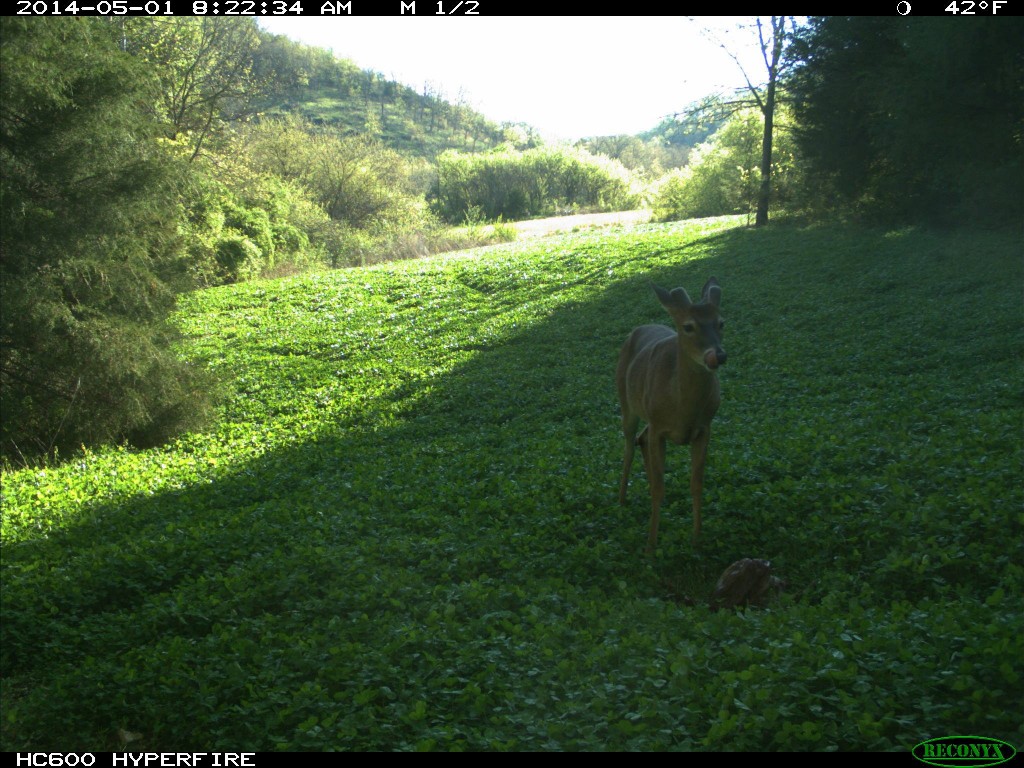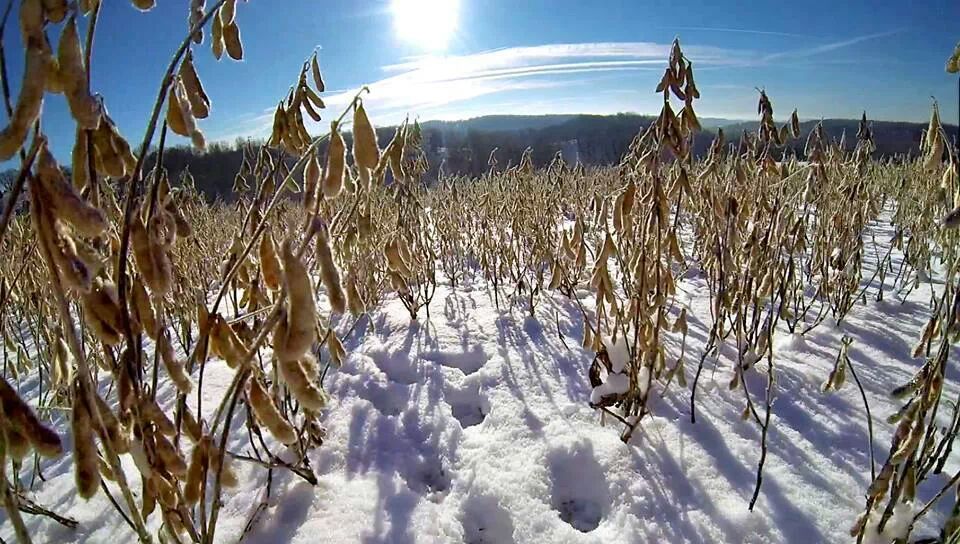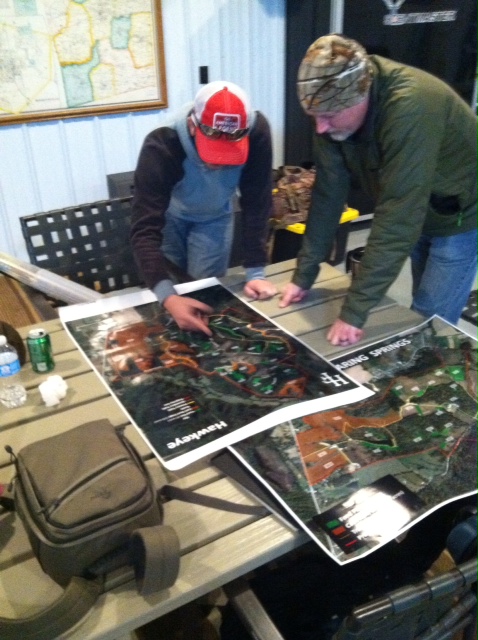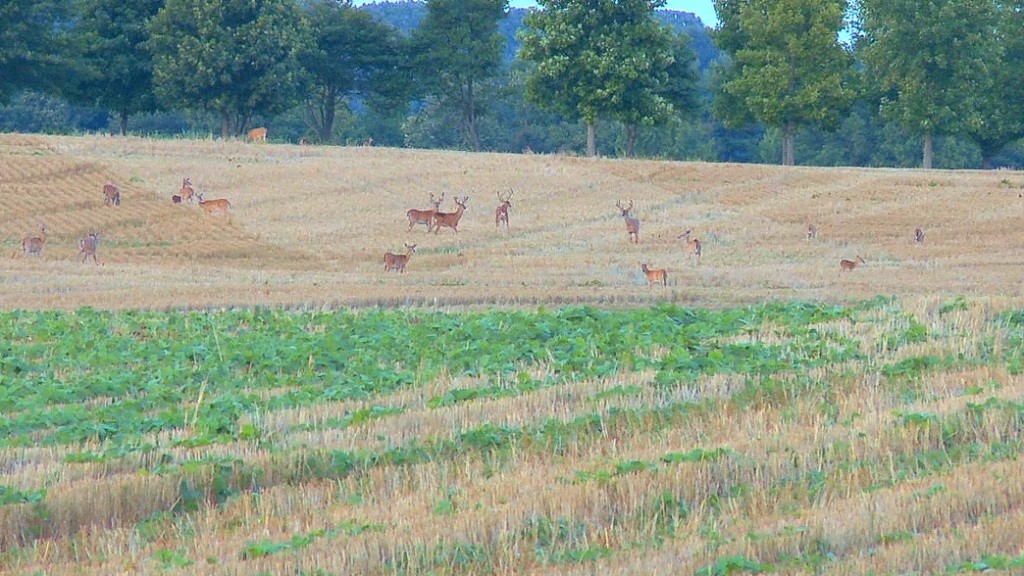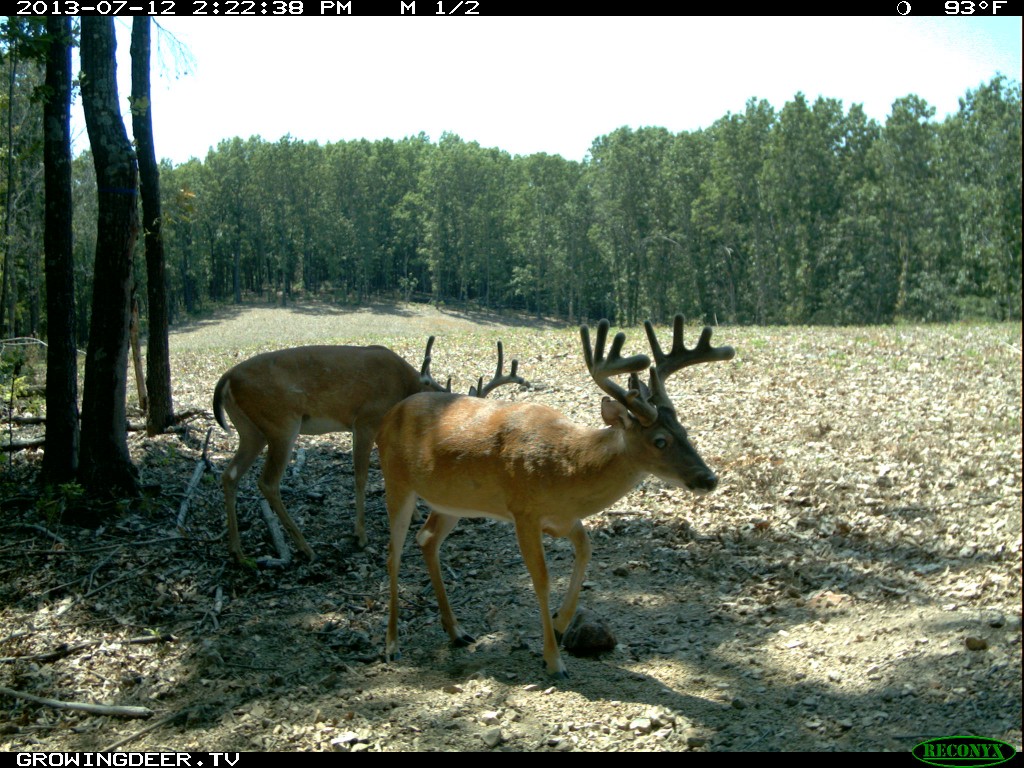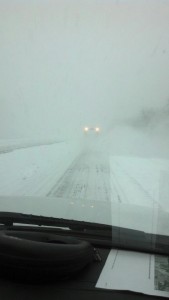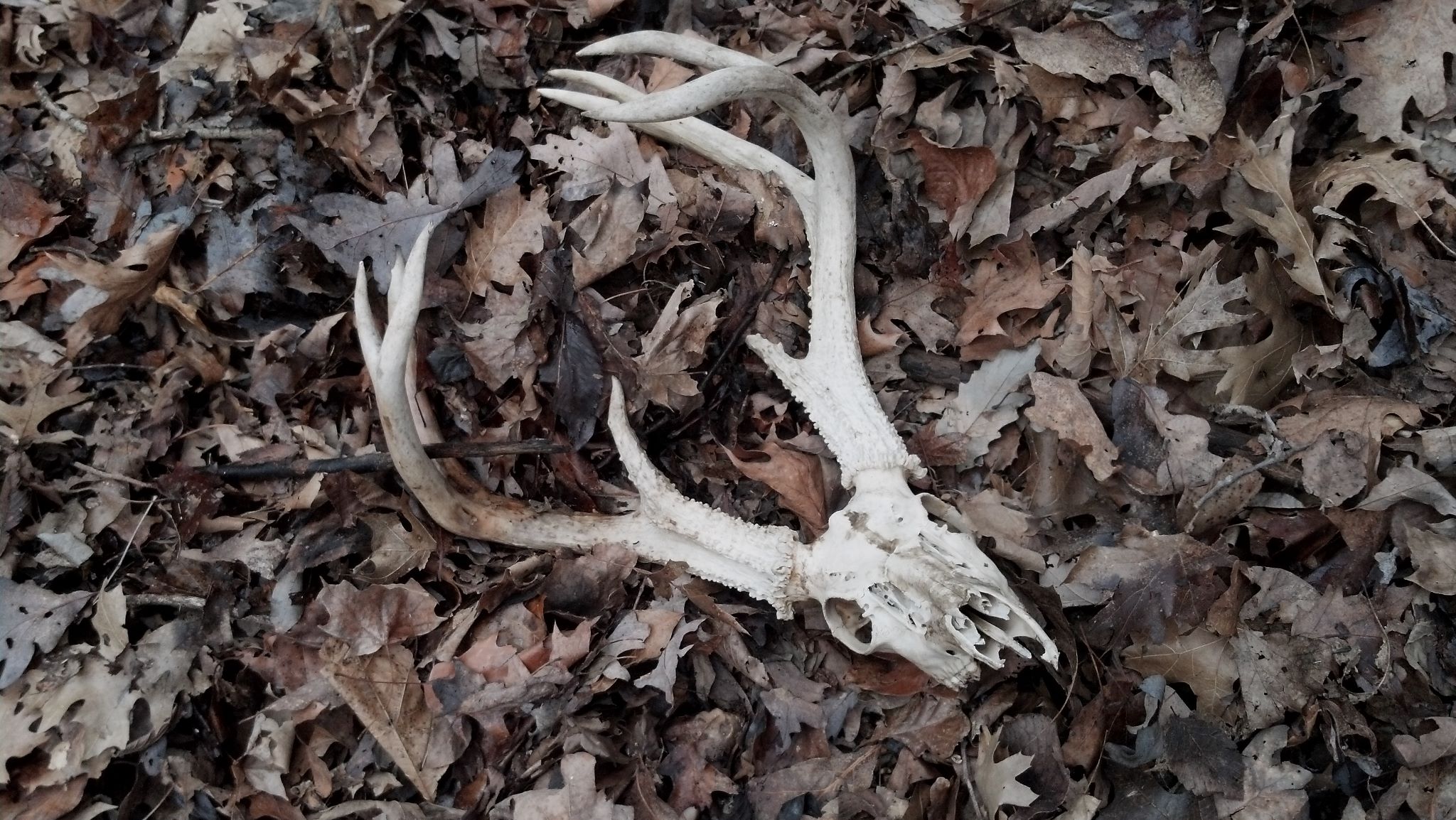Category: Deer Management
Trail Cameras Reveal Large Antlers Starting To Form!
It can be a depressing time of year for some people now that turkey season is wrapping up and the heat of summer is rapidly approaching! That’s not the case for the Growing Deer team as we started checking our Reconyx cameras! We are finding that bucks are already showing antler growth! Bucks have started showing up more regularly at our Reconyx stations, so tracking their growth will be exciting throughout the summer and into the fall.
One of the biggest factors in being able to following their progress is the use of Trophy Rocks. Trophy Rocks are one of the most attractive things you can use to lure deer in front of your cameras allowing you to monitor herd health, fawn survival, and antler growth. We use Trophy Rocks on The Proving Grounds year round, but a lot of people overlook the importance of having Trophy Rocks out during the spring because it isn’t hunting season. As a deer manager don’t forget that having the appropriate minerals and nutrition out year round will not only increase antler size and fawn survival but ultimately result in healthier deer.
Not only are Trophy Rocks great for improving deer health but they also make for some great Reconyx pictures! Stay with us this summer as we share the continual growth of our buck’s antlers!
To learn more about Trophy Rocks go to http://www.trophyrock.com/.
Daydreaming of whitetails,
Adam
Managing Whitetails: The Best Food Plots For A Cold Winter
If you look outside today in Branson, Missouri you’ll see a blanket of snow. We received 4 inches of snow Sunday and a few more inches Tuesday. This winter has certainly broken the trend set over the last few years. We have had numerous snowstorms that have left southern Missouri covered with snow. There are areas of the country that have received much more snow than we have!
Winters like these can be very stressful on wildlife. With a good portion of an animal’s food source covered with snow they have to resort to browsing on food sources above snow level or digging through the snow for food. Recently Grant and I took a walk to try and learn more about what our food plots were providing during the snow.
As we approached the food plot of standing beans you could obviously see the bean pods above the snow, with several deer tracks around. The deer had found the beans and were using them as a food source. Next, Grant and I stepped into a part of the food plot that was only wheat. The only thing you could see of the wheat was the very tip of the wheat which was covered in ice. Looking at this we also noticed there were not very many deer tracks in this section of the field. Probably because the deer would have to dig in the snow for food, while a better source of carbohydrates could be found not far away with the soybeans. Next, we moved to a section of the field that was planted in Eagle Seed Broadside blend. There were deer tracks in this part of the field but certainly not the amount of sign that was in the 100% bean field.
After all this walking around we pieced the information together to see what we could learn from these observations. First, on snow covered days the standing beans are hands down the most attractive thing we have provided. Second, a field of straight wheat isn’t going to provide much forage for deer when there are multiple inches of snow on the ground, although wheat can still be a great attractant when there isn’t snow. Finally, when considering the entire hunting season a food plot that provides both greens and standing beans can have the greatest attraction for deer. By planting Eagle Seed beans in the spring and then drilling back through them in the fall with the Eagle Seed Broadside blend we have the best combination food source that I have ever laid eyes on – a food plot that can provide year round forage and the most ideal forage during hunting season.
Daydreaming of whitetails,
Adam
How And When To Plan For Next Hunting Season: It Begins Now!
January 15th is a bitter sweet day for me. Why? January 15th marks the last day of archery season here in Missouri. On one hand I’m extremely upset that the season is over. We started chasing deer in the beginning of September and now, the middle of January, is when we hang up our Prime bows for a rest. That’s where the “sweet” part comes into play. After all these months it is nice to step back and take a breather and rest, charge our batteries, and clear our heads.
After we clear our heads we then start putting in thoughts and ideas for the upcoming season. Yes, you heard me correct. It’s January 17th and we’re already thinking about next deer season! Great management plans aren’t drawn up and executed in a matter of a few months – that’s why we’re starting now. Obviously we’ve been doing management projects throughout the season but we’ve postponed the projects that will add more disturbance to the property. Now with this season complete it’s time to start back up!
Like most years we start by looking at our map. Where are our stands located? Where is the food located? Where are the bedding, bottlenecks, and water sources located? Finally, how can we hunt the property more successfully? One of our biggest projects for this year is dealing with the southern part of The Proving Grounds. This part hasn’t been as highly managed and has very few food sources and stand locations. Our plan is to provide both of those and bring it all to you in coming months, stay tuned to GrowingDeer.tv!
Other goals we are looking forward to completing are clover maintenance and additions, invasive species control, and prescribed fire.
First we’ll talk clover. We manage about 10% of our food plots in clover. Every year we’ll watch it progress or decline and study which areas need to be replanted and which plots are being used heavily and could possibly be hunted more regularly.
Invasive species control can bore most people, including myself, but it’s part of good management. Over the last couple of years we’ve tackled a huge infestation of honey locust trees but I’m happy to say we’ve knocked about 90% of the population out and we’re now searching the hillsides for any squatters that may still be surviving. This next year we’ll be shifting our focus to multi-floral rose bushes. They’ve begun to spread into the food plot edges so it’s important for us to eliminate the problem before they start to gain ground and compete with the food sources we’ve planted.
Lastly, one of our biggest and most time consuming projects, prescribed fires. We spend a lot of time working for fire, it all starts by making the fire line to finishing it with the lighting of the fire. This is a huge project but when it’s all said and done the benefits are huge! Be sure to check out our progress throughout the off season!
But – we’re not completely locked up inside! Cabin fever is real ya know! We’re going to be doing a little predator hunting to see if we can’t have a little fun and deal with the depression of deer season closing.
Daydreaming of whitetails,
Adam
Bucks in Beans: Quality Bucks At Home!
I live and do most of my hunting near Branson, Missouri – about 20 miles from the Arkansas line. I live in the Ozark Mountains. Steep, rocky, and very low fertility soil. Low quality oak and fescue pasture make up the vast majority of habitat. There are no grain fields, combines, silos, etc., associated with production row crop ag and large bucks for many miles.
My favorite food plot crop here is soybeans! Clearly there’s a close association with soybeans and bucks producing larger antlers and does producing more fawns. Yearling, two, three, and older bucks tend to produce substantially larger antlers when they consume soybean forage during the summer and pods during the winter compared to only consuming native browse during the summer and acorns during the winter.
Larger antlers (per age class) are a great indication of herd health. I like healthy deer and the by-product of larger antlers! Soybeans are unquestionably one of the best food plot forages for deer.
The biggest limiting factor for soybeans is the total acreage of plots compared to the number of deer using those plots. For example, soybeans are not a good value for a ½ acre plot in an area with a lot of deer unless the plot is protected by a Hot Zone food plot protection fence. The fences are great to protect plots and allow soybeans to mature enough that deer won’t damage them by over-browsing the young plants.
I toured a farm yesterday that is in mountainous timber country! This area typically produces 110-120” mature bucks. The bucks are simply limited by nutrition. Saplings, acorns, and fescue pastures do not allow bucks to express their antler growth potential at any age class.
Over the past three years this landowner has converted some fescue pastures to food plots planted in soybeans. Yesterday we observed some great bucks! They were much better than average for that region!
I’ve seen the same thing in pine plantations in the South. I’ve commonly prescribed for clubs to plant the thinned rows in pine stands with soybeans (Watch GDTV 19) and have watched substantial increases in average antler size and the huntability of the bucks!
Soybeans are easy to grow just about anywhere and provide great nutrition for deer. Rather than wishing you could hunt deer like you watch on hunting shows filmed in the Midwest, create some soybean food plots and enjoy the same quality bucks at home!
Growing and hunting deer together,
Grant
Tools For Hunting Whitetails: A Trail Camera Deer Survey
We’ve been preparing for our annual trail camera survey! A trail camera survey has been shown to be the most accurate method to determine the number or deer, the age class of bucks, and the number of fawns per doe on a specific property. Detailed instructions of how to conduct a trail camera survey can be found at this link.
Placing trail cameras and attractants like Trophy Rocks and Record Rack feeds is the easy part of conducting a trail camera survey. Plus, it’s always fun to look at all the deer pictures. Looking at each picture close enough to uniquely identify each buck can be very labor intensive. We usually end up looking at the same pictures many times to confirm the buck is the same (or different) as in other pictures.
A very accurate estimate of the total population and herd demographics can be obtained after identifying each individual buck, the number of times that buck was photographed, and the total number of does and fawns appearing in the pictures.
With the hard work completed, there’s still lots more valuable information that can be gained from all these photos! For example, I pay very close attention to which mature bucks tend to be active more during shooting light! Those bucks will usually be much easier to tag than bucks that only show up at camera sites after dark.
I also pay close attention to how the bucks, especially mature bucks, respond to each other. I look for mature bucks that are more active during daylight than other bucks and show signs of being aggressive at the camera site. Signs of aggression may be that the buck is usually the first to show up among other bucks in the bachelor group. The aggressive bucks are often photographed chasing other bucks away from the camera site.
These aggressive bucks tend to respond much better to grunt calls, rattling, and decoys. I’ll gladly spend my time hunting for an aggressive buck versus a buck that has larger antlers, but shows sign of being totally nocturnal. Such bucks may be practically unkillable – at least that year.
Currently, I’m getting a lot of images of a buck that I believe is six years old or older (based on the Reconyx trail camera images). We call him Split Brow because two years ago he had split brow tines. We’ve only had a small handful of daytime pictures of Split Brow in several years (from 1,000’s of pictures). Currently he’s showing up in front of one of my Reconyx cameras during shooting light daily! If this pattern continues, Split Brow will be at the top of my hit list due to his age and tendency to move during shooting light.
Camera surveys are a great tool for deer managers – and very useful to learn the characteristics of individual bucks! This info has served well to make me a much better hunter!
Growing and hunting deer together,
Grant
Whitetail Management: Stress And Genetic Potential
Removing stress from wildlife allows them to express more of their genetic potential. As managers we don’t improve genetics of free-ranging wild creatures. That requires knowing the pedigree (the sire and dam for several generations) which is totally impractical in free-ranging wild populations.
The best we can do is manage the population and habitat so each individual can express their full genetic potential. For example, a mature buck that’s limited to consuming hardwood twigs and fescue won’t produce as large of antlers or body size as that same buck if it was consuming soybean forage during the summer and soybean pods (and other forages) during the winter.
Managers can reduce the stress deer and other forms of wildlife experience by improving the quality of food, cover, and water and reducing the number of predators (should the predator/prey populations be out of balance). The natural world is dynamic. That is to say the balance of the number of critters in relation to the amount of quality food, cover, water, and predators is always changing!
We’re expecting a significant change later this week at The Proving Grounds. There’s a good chance of snow in the forecast! I heard on the radio that snow hasn’t been recorded in May in my area for more than 100 years. The cold conditions that are associated with this storm will certainly be very stressful for deer that have begun to shed their winter coat and replace it with the shorter, thinner summer coat. Staying warm will cost critters a lot of energy.
There are probably a couple of newly born fawns at my place. Most fawns are born during late May/early June, but there are always those that are born a few weeks earlier or later than “normal.” Freezing wet conditions will make survival very tough on newborn fawns.
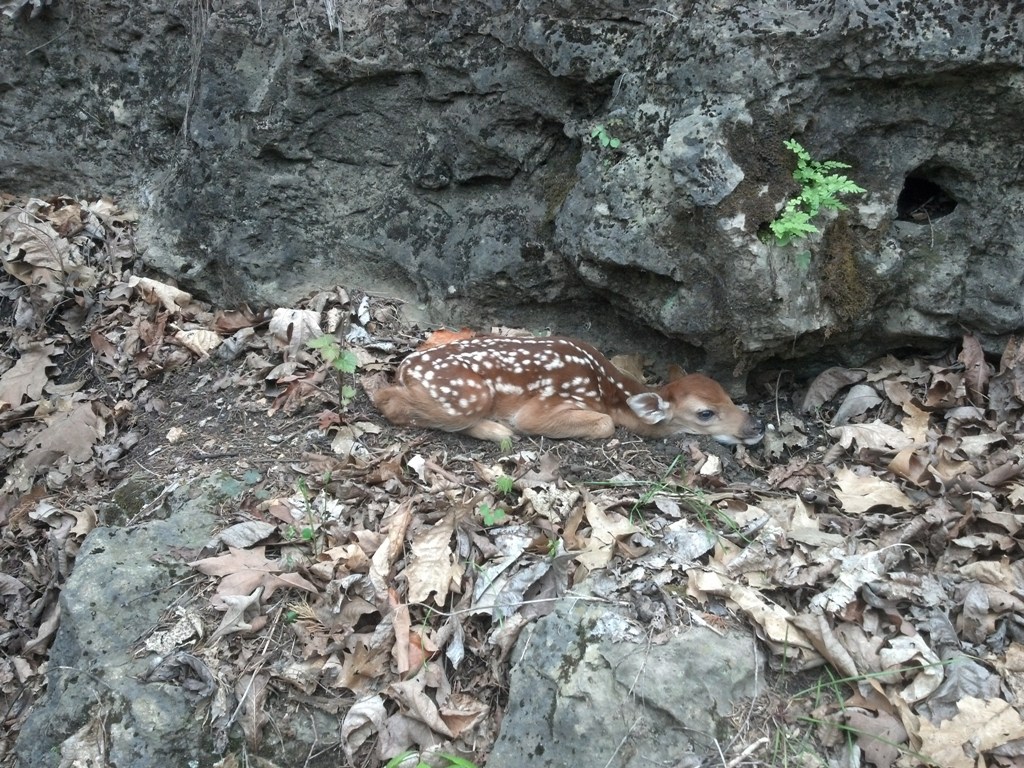
Most fawns are born during late May/early June but there are always those that are born a few weeks earlier or later.
Likewise there are probably a few turkey poults that have hatched already. Cold wet conditions will likely result in a 100% loss of those early born poults.
We can’t change (or even accurately predict) the weather. We can manage the habitat to provide quality food, cover, and water to help wildlife survive such storms. It’s critical to manage the wildlife populations so that there is more food than required during good conditions – as bad conditions will always occur.
We manage for very high quality native forage and cover at The Proving Grounds. There’s plenty to eat, fresh water to drink, and great cover for wildlife to seek during this arctic blast. Such storms have probably occurred before weather records were kept and they’ll probably occur again. That’s why quality habitat management is critical for allowing wild, free-ranging deer to express their potential. As managers, we can have an impact on the habitat quality and the amount of genetic potential the local herd expresses. We can’t impact the genetic quality of wild, free-ranging deer. I’m glad we can’t – that’s what makes them wild!
Growing Deer together,
Grant
Coyote Hunting Tips And Techniques
It’s Friday February 22nd and Grant and I just returned late last night from a coyote hunt in Hamilton, Illinois with Jason Gilbertson and Mike Stock from Winchester Ammunition. Along with their friend Tyler Sellens of Riverview Outfitters. As most of you are aware there was a large winter weather front sweeping across the Midwest on Wednesday and Thursday, so Grant and I headed up on Tuesday hoping to get a couple days of hunting coyotes in before the winter weather hit.
With the threat of wintry weather Grant and I thought it would be a great time to catch some predators trying to find a quick meal before the storm hit. Plus, we would also spend some time with our friends at Winchester Ammo doing something exciting like chasing coyotes! On Wednesday Grant was busy working on a property near Princeton, Illinois so I teamed up with Mike and Tyler for the day. We had a fun day chasing coyotes. At the end of the day Mike headed home just as Jason and Grant arrived to hunt the following day. Before I give away the outcome of our success, you can catch this two day coyote hunt on the upcoming episode of GrowingDeer.tv (GDTV 171)! During this hunt I noticed some different techniques that I’ll share with you now.
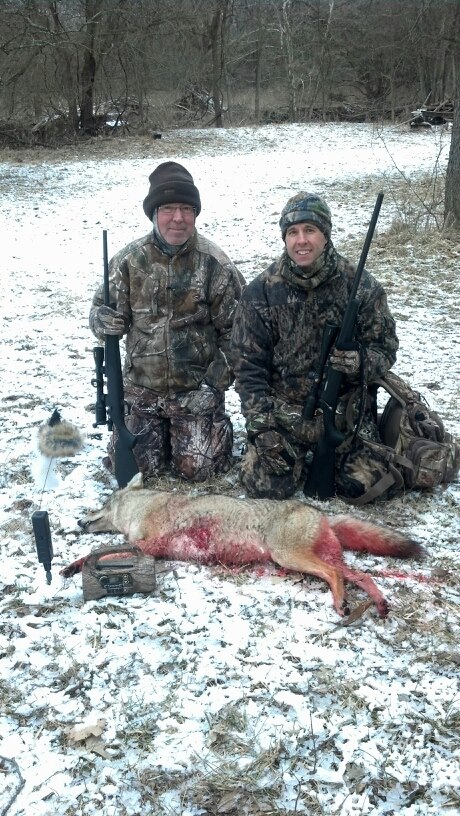
Using these techniques could ultimately lead to a successful predator hunt.
- Approach. You often hear Grant talk about MDE (minimal disturbance entry) for deer hunting, this is also important to coyotes. Our most successful trips happen when we use a hill or slope to our advantage. Approaching from a backside of a hill and just breaking over the top so we’re not alerting anything when approaching is a great way to sneak attack coyotes!
- Crosswinds. Of course when deer hunting, a wind that is consistently in your face is ideal, but sometimes with coyotes they can hang up out of sight because the situation is too risky for them. We typically want our wind direction to be blowing across a field or open area so when a coyote does approach downwind he’s in sight and you can take the shot!
- Be ready! A lot of times coyotes can run into your setup in under a minute of turning on the caller. This happened numerous times during our Illinois hunt. Once the caller had only been on for 36 seconds! With that being said, when the caller is turned on be ready!
- Timing. Coyote breeding season here in Missouri is typically mid to late February so its prime time to call coyotes. Coyotes are very vocal during this time so don’t be afraid to make a few howls either, it might be the only temptation you need to bring one within range.
It’s a slow time of year for deer hunters but an exciting time of year for predator hunters! It’s a great way to ease your cabin fever during these slow months between deer and turkey seasons.
That winter storm swept cross Missouri it dumping everything from freezing rain, sleet, to snow in northern parts of Missouri. Reports of up to 17 inches in places, but in Branson, Missouri there was primarily just sleet and freezing rain. Conditions were very hazardous when we made our venture home; generally it’s a 6 hour drive from Keokuk, Iowa where we were staying to Branson. Last night it took just over 12 hours. Today we are thankful for making it home safely with memories stored away of exciting and challenging days hunting those wiley coyotes!
As always – stay safe and good luck removing predators!
Dreaming of Giant Whitetails,
Adam
Shed Antler Hunting: The Aftermath of EHD
It’s been a busy week here at The Proving Grounds. Missouri trapping season is coming to a close and we’re also in the middle of our post season camera survey. These days are usually busy for the GrowingDeer.tv Team as we check our Duke Traps every morning and replenish the Record Rack feeding stations. It was during this time when I received a phone call from Mrs. Tracy saying she had found a “sure enough big buck.”
As many of our loyal viewers know, Mrs. Tracy loves to shed hunt with her dog, Crystal. Grant, Brian, and I are leaving January worn down from the long haul of deer season but Mrs. Tracy is just getting fired up! With the close of archery season on January 15th Mrs. Tracy heads to the woods to start looking for sheds and skulls of the bucks who didn’t survive the season. Especially after this year, with the outbreak of EHD (Epizootic Hemorrhagic Disease), as the shed hunting enthusiasts start their search for those treasured antlers, they will have their hands full of EHD stricken deer remains. There are a couple reasons why I feel this will happen.
We are beginning to switch out of hunting and back into the management side of things. We are starting to enter into parts of the property that have been left untouched during the hunting season. As we’ve started doing these projects we have been finding carcasses, both recent and from months ago when EHD hit the hardest. For example, Monday we began collecting soil samples and in a few hours of work we had already found two carcasses by the creek we were working by.
As the season progressed here at The Proving Grounds we noticed that some of our bucks had come up missing. First there was Bean Flipper in late August, then Tightwad in mid-September, next Giant 8 in late September and finally Pumpkin face (after a firsthand encounter in early November). Typically bucks are not as easy to pattern during the rut but as we enter a late season feeding pattern we would expect to see them on our Reconyx cameras. We’re now almost into February and still haven’t seen “hide nor hair” from these bucks, until I got the phone call.
I could hear the excitement in her voice and I was just hoping she couldn’t hear the disappointment in mine. She had found a large buck dead and now my only thought was, “Who is it?” She sent a picture to my phone and based on what looked like split G2s my instincts told me it was Bean Flipper. After we hiked down the valley to her and the buck, I put my hands on the antlers and crossed Bean Flipper of the MIA list. You can catch the entire recovery on next Monday’s episode at GrowingDeer.tv (GDTV 167).
As we make our way into the post season/shed hunting time of year, the GrowingDeer.tv Team will start focusing on who survived and who still remains MIA, and we’ll bring it all to you right here semi-live!
Good luck to all of you planning on hitting the woods searching for sheds!
Dreaming of Giant Whitetails,
Adam
Managing Whitetails: Habitat Design
This morning I toured a 280 acre tract of land recently purchased by the owners of Redneck Hunting Blinds. The property is in west central Missouri. It’s about 50% tillable land and 50% hardwood forest. A power line and a gas right of way cross the property. Basically the timber is on the west of the property and the crop ground on the east.
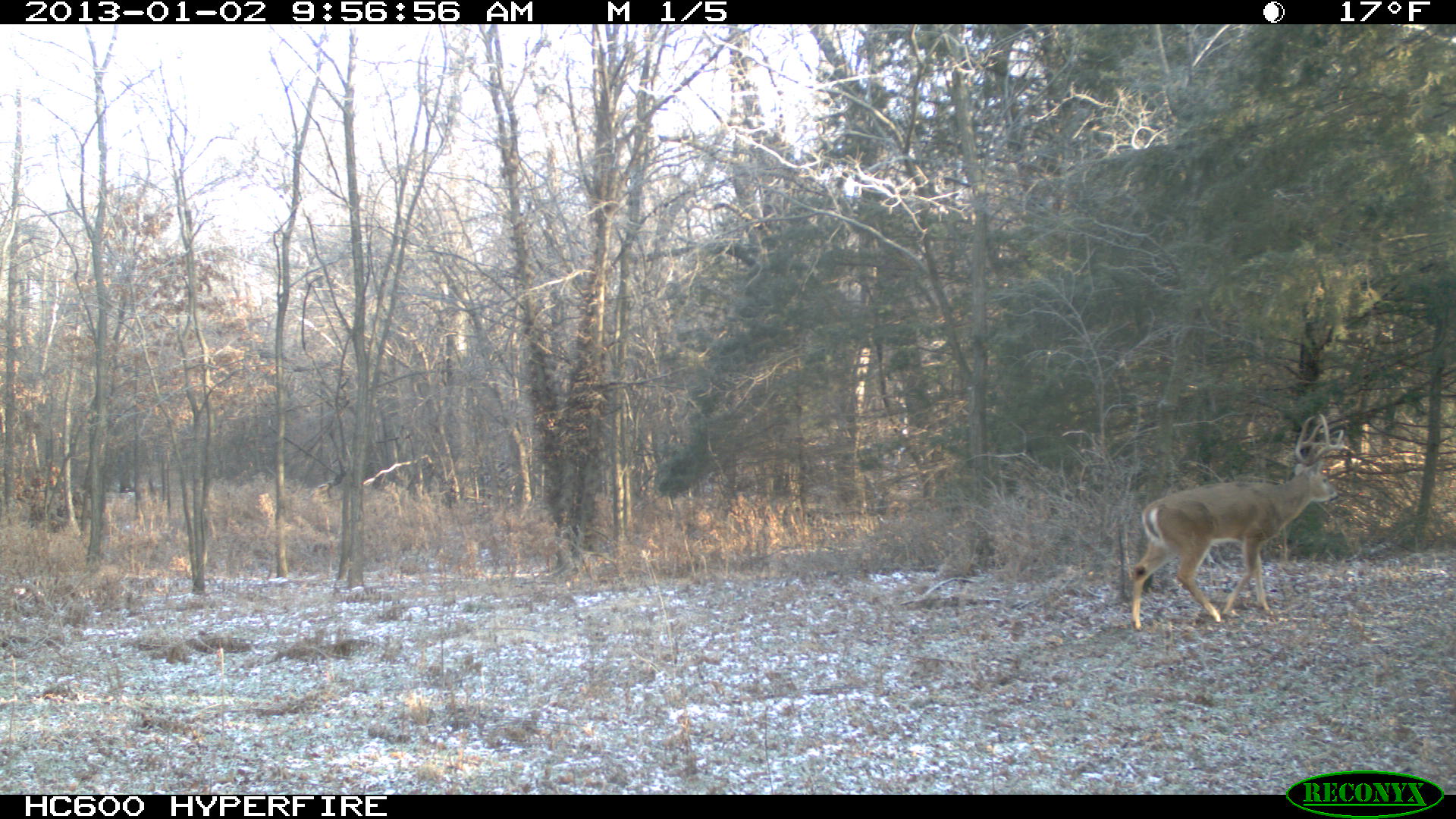
It’s a long way from finding one set of sheds to producing and harvesting two mature bucks annually.
The area has much potential as we found both sheds to the buck in this picture. However, it’s a long way from finding one set of sheds to producing and harvesting two mature bucks annually.
My goal is to design a habitat management and hunting strategy that will yield an average of two mature (4+ year old) bucks to harvest annually – or a mature buck per 100+ acres. That’s a very tall order! However, the habitat is conducive to that objective. I’m not sure about the neighborhood yet.
I always begin by assessing the availability and quality of food, cover, and water. It seems most folks focus on food – either row crop or food plots. However, deer, especially mature bucks, spend the majority of their time during daylight hours in or near cover. This is especially true in areas where row crop ag is the primary land use – especially after the crops are harvested.
The Redneck Proving Grounds has some cover, but no sanctuaries. That’s to say there were no areas where there wasn’t sign (treestands, ATV trails, etc.) of hunting activity. One of my first thoughts during the tour was that I need a plan to encourage mature bucks to spend a majority of their time on the Redneck Proving Grounds. I will accomplish this by creating three sanctuaries in different corners of the properties!
Let me know if you’d like to follow this project closer and I’ll share step by step my plans and the progress.
Growing Deer together,
Grant
The Deer Hunter’s Second Season: Shed Hunting
There are a few more days of archery season in Missouri and a few other states. Grant and the boys still have a few days to fill their tags here at The Proving Grounds. Once archery season ends, Grant will give me permission to start my season – shed hunting! Late winter is the time that I enjoy most here in Missouri. The woods are free of ticks and snakes. The brush has died back so that the hills and glades are easier walking. Best of all – Crystal and I can find special treasures while walking these Ozark Mountains – shed antlers! (Crystal is a Labrador Retriever that I have trained to find and retrieve shed antlers.)
Shed hunting in the Ozarks is not like shed hunting in the states that have flat land like Iowa, Kansas, or Illinois. I envy the folks that can go shed hunting and spot one 300 yards away! Finding a shed in these hills is akin to an Easter egg hunt where the eggs are well hidden. When you find a shed you consider it a special blessing!
My first objective will be to initially walk the valleys in search of deer that may have died during the fall from EHD. Our valley contains a creek that although it isn’t a perennial, flowing source of water, it does have certain deeper holes that held water even through this last summer’s drought. Those are the targets for my initial hunts. Crystal and I will be looking, but not necessarily hoping, to find the bucks that were lost due to the disease. Our fear is that we will find many more like the one Grant recently found pictured below and the one shown in the GrowingDeer.tv video back in September (GDTV 147).
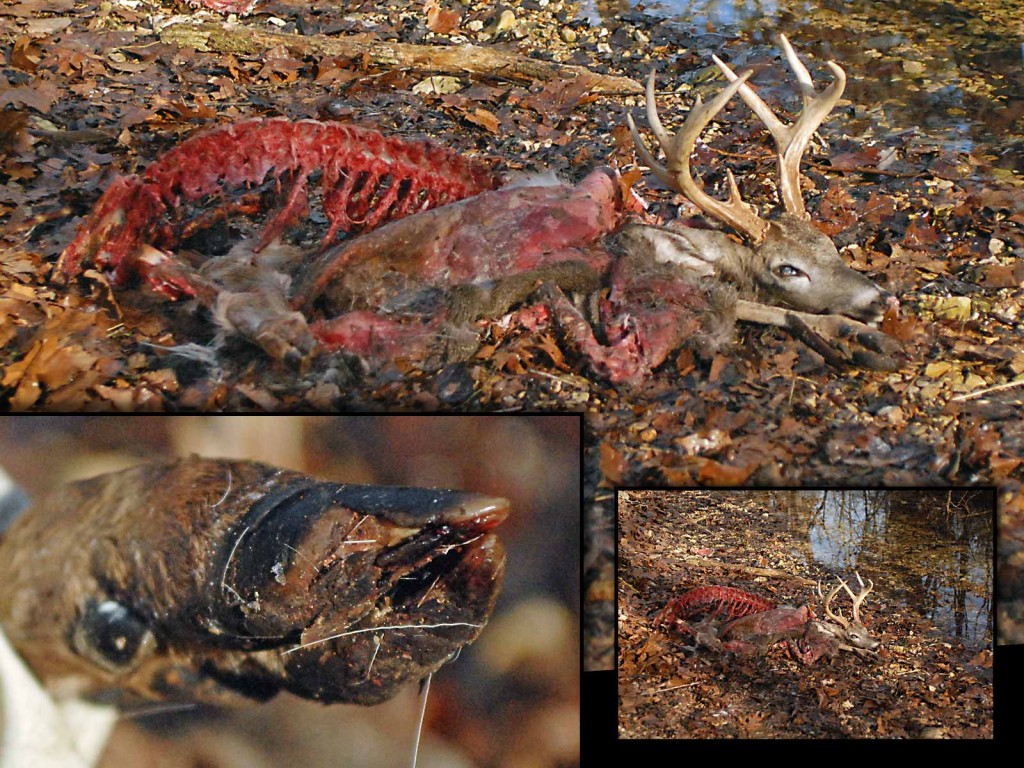
Initially I will walk the valleys in search of deer that may have died during the fall from EHD, like the buck pictured above.
On the brighter side, hunting in the valley has an additional benefit – it is relatively flat which will be the beginning of conditioning for both Crystal and me for the harder exercise of searching the hills!
Once the water sources have been hunted I will move on to the rest of the property. Grant and the boys will still be using the Reconyx cameras to monitor the deer herd to determine which bucks made it through the season. As soon as bucks start to show they are loosing antlers, I will develop specific areas to canvas based on the travel patterns shown by the Reconyx MapView software. Perhaps we’ll get lucky like we did last year (see it here in GDTV 116) and the Reconyx will capture images of one of our hit list bucks the night that he sheds his antlers!
Grant and I will be sharing some other tactics to help you find shed antlers in future blog posts. In the meantime – get out there to get some exercise and enjoy Creation! Enjoy the shed hunting season and share when and what you find on our Facebook page! I look forward to hearing about and seeing all the great treasures you find in the next few weeks.
Enjoying Deer together,
Tracy Woods



